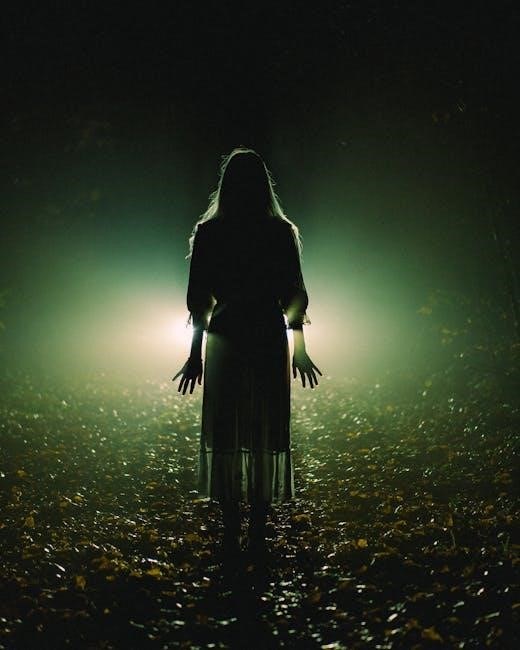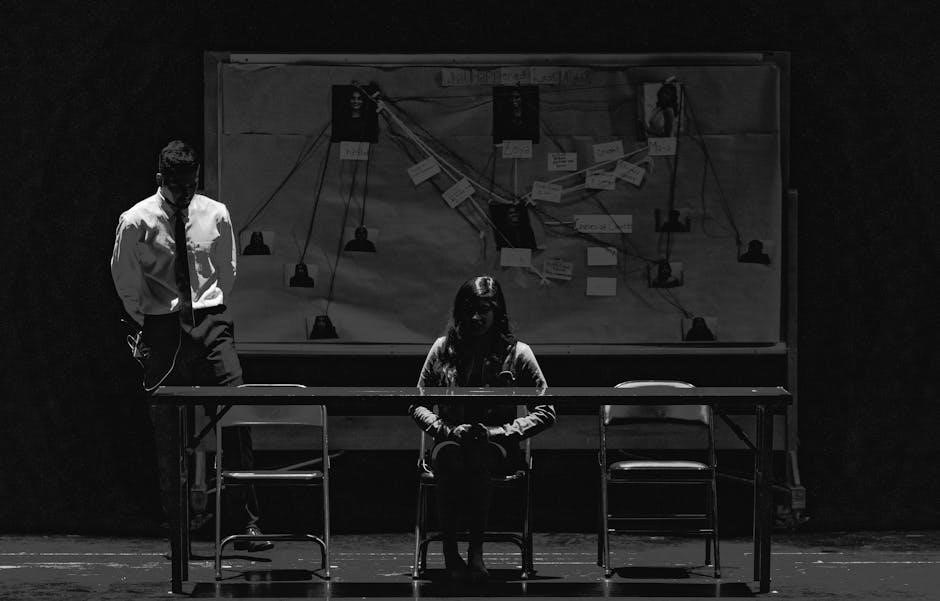The novel is easily accessible in various digital formats, including free PDF versions, allowing readers to explore its timeless themes and haunting narrative.
1.1 Overview of the Novel
The Strange Case of Dr. Jekyll and Mr. Hyde, written by Robert Louis Stevenson, is a gothic novella that explores the dual nature of human personality. The story revolves around Dr. Henry Jekyll, a scientist who creates a potion to unleash his darker impulses, transforming him into the sinister Mr. Hyde. As Hyde’s influence grows, Jekyll’s control weakens, leading to a tragic confrontation. The novel delves into themes of morality, identity, and the struggle between good and evil; Its gripping narrative and psychological depth have made it a classic, with the PDF version widely available for free download from sources like Planet eBook and Project Gutenberg, ensuring its accessibility to modern readers.
1.2 Historical Context
The Strange Case of Dr. Jekyll and Mr. Hyde was first published in 1886 during the Victorian era, a time of rigid social norms and moral expectations. The novella reflects the era’s preoccupation with duality, as Victorians often struggled with public respectability and private desires. Stevenson drew inspiration from contemporary debates on morality and the emerging field of psychology. Additionally, the story’s themes of identity and transformation resonated with the public’s fascination in folklore and mythology. The novel’s exploration of repressed instincts also aligns with the era’s growing interest in human nature. Today, the PDF version of this gothic classic remains widely accessible, preserving its historical and literary significance.
1.3 Author Background: Robert Louis Stevenson
Robert Louis Stevenson, born in 1850 in Edinburgh, Scotland, was a renowned Scottish novelist, poet, and travel writer. His works often explored themes of human duality and moral complexity, as seen in The Strange Case of Dr. Jekyll and Mr. Hyde. Stevenson’s literary career was marked by a blend of romance, horror, and psychological insight. Despite battling health issues, he produced iconic novels like Treasure Island and Kidnapped. His writing style, both vivid and introspective, has left a lasting impact on world literature. The PDF version of his works, including Dr. Jekyll and Mr. Hyde, remains a popular choice for readers seeking classic Gothic narratives.

Themes and Symbolism
The novella explores the duality of human nature, symbolized by Dr. Jekyll and Mr. Hyde, highlighting the internal conflict between good and evil, morality, and hidden desires.
2.1 Duality of Human Nature
The novel masterfully portrays the duality of human nature through Dr. Jekyll and Mr. Hyde, symbolizing the internal struggle between good and evil. This theme is central to the story, exploring how individuals can harbor both virtuous and darker impulses. The character of Dr. Jekyll represents the civilized, moral aspect of humanity, while Mr. Hyde embodies the primitive, sinful side. This duality serves as a metaphor for the universal human experience, where individuals constantly navigate between their higher aspirations and base desires. Stevenson’s portrayal of this psychological conflict remains a profound commentary on human complexity, making the novel a timeless exploration of inner turmoil and moral ambiguity.
2.2 Morality and Ethics
The novel delves into the complexities of morality and ethics, questioning the boundaries between right and wrong. Dr. Jekyll’s experiments reveal the dangerous allure of unchecked ambition, while Mr. Hyde’s actions expose the depths of human depravity. The story explores the moral responsibility that accompanies scientific and personal freedom, highlighting the ethical dilemmas of pursuing knowledge without accountability. Through its characters, the novel critiques the hypocrisy of Victorian society, where outward virtue often masks inner corruption. Stevenson’s exploration of morality and ethics remains a powerful commentary on the human condition, urging readers to reflect on their own values and the consequences of their choices.
2.3 The Nature of Good and Evil
The novel vividly examines the duality of good and evil through Dr. Jekyll and Mr. Hyde, illustrating their opposing natures. Dr. Jekyll represents the civil, rational, and moral aspects of humanity, while Mr. Hyde embodies the primitive, brutal, and depraved forces within. Stevenson’s portrayal suggests that good and evil are not separate entities but intertwined parts of the human psyche. The struggle between these opposing forces highlights the internal conflict individuals face in maintaining their moral integrity. By exploring this duality, the novel challenges readers to confront the darker aspects of their own nature and the societal constraints that suppress or unleash these impulses. This timeless theme continues to resonate with audiences today.

Characters and Characterization
The novel centers on Dr. Jekyll and Mr. Hyde, showcasing their contrasting personalities and the duality of human nature. Supporting characters like Utterson and Poole add depth to the psychological conflict.
3.1 Dr. Henry Jekyll
Dr. Henry Jekyll is a respected scientist and gentleman whose curiosity about human duality leads him to create an alter ego, Mr; Hyde. Jekyll is portrayed as a man of great intellect and moral ambition, yet his obsession with separating his darker impulses from his respectable persona drives the tragic events of the novel. His transformation into Hyde symbolizes the internal struggle between good and evil, exploring themes of identity and morality. Through Jekyll’s character, Stevenson examines the complexities of human nature and the consequences of unchecked desires. Jekyll’s eventual downfall underscores the fragility of the human psyche.
3.2 Mr. Edward Hyde
Mr. Edward Hyde is the dark, sinister alter ego of Dr. Henry Jekyll, embodying the repressed evil within him. Hyde is described as a small, deformed man with an unsettling appearance that inspires fear and revulsion. His brutish and immoral nature contrasts sharply with Jekyll’s respectability, symbolizing the duality of human nature. Hyde’s actions are driven by unchecked desires, leading to violence and chaos. Despite his power over Jekyll, Hyde is ultimately a tragic figure, representing the destructive forces of unchecked evil. His character serves as a mirror to Jekyll’s psyche, highlighting the struggle between good and evil that defines the novel’s central theme.
3.3 Supporting Characters
The supporting characters in The Strange Case of Dr. Jekyll and Mr. Hyde play pivotal roles in unraveling the mystery. Mr. Utterson, a lawyer and Jekyll’s friend, drives the narrative by investigating Hyde’s connection to Jekyll. His cautious and methodical nature contrasts with the dark forces he uncovers. Dr. Hastie Lanyon, another friend, provides insight into Jekyll’s past, while Poole, Jekyll’s loyal butler, exemplifies unwavering loyalty despite his growing fear of Hyde. Minor characters like Sir Danvers Carew, whose murder by Hyde shocks society, and the maid who witnesses the crime, add depth to the plot. These characters collectively illuminate the duality of human nature and the moral compromises that bind them to Jekyll and Hyde’s fates.

Availability in PDF Format
The Strange Case of Dr. Jekyll and Mr. Hyde is widely available in PDF format for free download from sources like Planet eBook and Google Books.
4.1 Sources for Download
The Strange Case of Dr. Jekyll and Mr. Hyde is widely available in PDF format from various reputable sources. Planet eBook and Google Books offer free downloads, providing easy access to the classic novella. Additionally, platforms like LitRes and Project Gutenberg host digitized versions, ensuring the book’s availability for readers worldwide. Many of these sources are volunteer-driven initiatives, making the text accessible to anyone with an internet connection. These platforms cater to different reading preferences by offering multiple formats, including PDF, EPUB, and MOBI, ensuring compatibility with various devices like e-readers, tablets, and smartphones.
4.2 Free vs. Paid Versions
The Strange Case of Dr. Jekyll and Mr. Hyde is available in both free and paid PDF versions. Free versions can be downloaded from platforms like Planet eBook and Project Gutenberg, which offer high-quality, digitized texts without cost. These are ideal for casual readers seeking access to the classic novella. Conversely, paid versions are available through major eBook retailers like Amazon and Barnes & Noble, often featuring enhanced formatting, annotations, and additional scholarly content. While free versions suffice for most readers, paid editions provide a more polished reading experience, making them appealing to enthusiasts and students requiring detailed study materials.
4.3 Quality and Formatting
The quality and formatting of PDF versions of The Strange Case of Dr. Jekyll and Mr. Hyde vary depending on the source. Free versions from platforms like Project Gutenberg and Planet eBook are well-formatted and readable, though they may lack advanced features. Paid versions often include enhanced formatting, such as adjustable fonts, tables of contents, and annotations, making them more user-friendly for academic or in-depth reading. Additionally, some paid editions feature introductions by literary critics, providing context that enriches the reading experience. Ensuring the PDF is from a reputable source guarantees a clear and enjoyable read, whether for personal enjoyment or scholarly purposes. Proper formatting enhances accessibility and readability across various devices.

Plot Summary and Analysis
The novella explores Dr. Jekyll’s dark experiment and Mr. Hyde’s sinister deeds, unraveling a tale of dual identity and moral conflict, culminating in tragic consequences.
5.1 The Strange Case Unfolds
The story begins with Mr. Utterson’s investigation into the mysterious connection between Dr. Jekyll and the sinister Mr. Hyde; A chilling incident involving Hyde’s brutality sparks Utterson’s curiosity. As the narrative progresses, the dual identity of Jekyll and Hyde is revealed through letters and confessions. The novel explores themes of morality, with Jekyll’s scientific experiments unleashing his darker half, Hyde. The unfolding plot exposes the clash between Jekyll’s civilized nature and Hyde’s primal desires, leading to a tragic confrontation. The novella’s suspenseful structure keeps readers engaged, culminating in a shocking climax that reveals the ultimate fate of Jekyll and Hyde. The story is a timeless exploration of human duality.
5.2 Key Plot Points
The story revolves around the mysterious connection between Dr. Henry Jekyll and the sinister Mr. Edward Hyde. A series of disturbing events, including Hyde’s brutal assault on a young girl, sparks the curiosity of Jekyll’s friend, Mr. Utterson. Utterson discovers a will that leaves Jekyll’s estate to Hyde, fueling suspicions. As the narrative unfolds, Jekyll’s dual identity is revealed through letters and confessions. The transformation between Jekyll and Hyde is central to the plot, highlighting the struggle between good and evil. The story reaches its climax when Hyde disappears, and Jekyll isolates himself, leading to the tragic revelation of his ultimate demise. The novel masterfully explores the psychological and moral complexities of Jekyll’s internal conflict.
5.3 Climax and Resolution
The climax occurs when Dr. Jekyll, unable to control his transformations, isolates himself, fearing Hyde’s dominance. In a desperate attempt to regain control, Jekyll locks himself in his laboratory. Meanwhile, his friends break in, only to find Hyde, who has taken Jekyll’s form. The resolution comes with the discovery of Jekyll’s letters, revealing his tragic struggle with his dual identity. Jekyll’s ultimate demise is revealed, as he takes his own life to prevent Hyde’s permanent takeover. The novel concludes with a sense of moral reckoning, as the truth about Jekyll and Hyde is finally understood, leaving readers to ponder the darker aspects of human nature.

Adaptations and Interpretations
The story has inspired numerous film adaptations, stage plays, and modern reinterpretations, showcasing its timeless exploration of human duality and moral complexity.
6.1 Film Adaptations
The story has been adapted into numerous films, each offering unique interpretations; Notable versions include the 1920 silent film starring John Barrymore and the 1931 adaptation with Fredric March, which won an Academy Award. The 1941 film featuring Spencer Tracy and Ingrid Bergman added depth to the characters. Modern adaptations, such as the 2008 TV movie with Dougray Scott, explore psychological complexity. These films capture the essence of the novel while introducing new perspectives, showcasing the timeless appeal of Stevenson’s tale of duality and moral struggle. Each adaptation highlights the enduring fascination with Dr. Jekyll and Mr. Hyde’s haunting story.
6.2 Stage Productions
The story has been adapted into numerous stage productions, with the first play premiering in 1887, just a year after the novel’s publication. These adaptations often emphasize the psychological struggle between Dr. Jekyll and Mr. Hyde, using dialogue and stage settings to convey the duality of human nature. The challenge of portraying the two contrasting characters in a single actor has made the play a favorite among performers. Stage productions have also explored themes of morality and identity, resonating with audiences worldwide. The theatrical interpretations continue to highlight Stevenson’s timeless narrative, ensuring its enduring appeal in the realm of live performance and drama.
6.4 Modern Interpretations
Modern interpretations of The Strange Case of Dr. Jekyll and Mr. Hyde often explore its psychological and philosophical themes through contemporary lenses. Many filmmakers and authors reinterpret the story to reflect modern societal issues, such as mental health, identity crises, and the duality of human behavior in the digital age. Some adaptations even reimagine the characters in new contexts, such as urban settings or futuristic worlds, while maintaining the core tension between good and evil. These reinterpretations highlight the timeless relevance of Stevenson’s work, allowing new generations to connect with its universal themes. The story’s adaptability ensures its enduring presence in modern culture.

Study Guides and Resources
Various study guides and educational resources are available online, offering in-depth analysis, summaries, and discussion questions. These materials enhance understanding of the novel’s themes and complexity, ideal for students and readers seeking deeper insights.
7.1 Educational Tools
7.2 Essay Topics and Ideas
Essay topics for The Strange Case of Dr. Jekyll and Mr. Hyde could explore the duality of human nature, morality, and the psychological struggle between good and evil. Students might analyze how Stevenson uses Hyde to symbolize repressed desires or examine the societal pressures that drive Jekyll’s transformation. Another angle could be the role of Victorian-era morals in shaping the narrative. Additionally, essays could compare the novel’s themes with modern psychological theories or discuss the impact of the novella’s ending on its interpretation. These topics encourage deep analysis of the text and its relevance to human experience, making them ideal for academic exploration and discussion.
7.3 Reading Comprehension Aids
Reading comprehension aids for The Strange Case of Dr. Jekyll and Mr. Hyde include study guides, annotations, and summaries to enhance understanding of the novel’s complex themes. Many PDF versions of the book come with integrated study materials, such as vocabulary lists and character maps. Additionally, online resources offer chapter-by-chapter analyses and discussion questions to deepen comprehension. Tools like reading apps and e-book highlights can also assist readers in tracking key plot points and symbolic elements. These aids are particularly useful for students or those unfamiliar with Victorian literature, helping them grasp the nuances of Stevenson’s writing and the psychological depth of the story.

Psychological Insights
The novel explores the duality of the human psyche, highlighting themes of repression and the struggle between good and evil through Dr. Jekyll and Mr. Hyde.
8.1 Freudian Analysis
From a Freudian perspective, Dr. Jekyll and Mr. Hyde symbolize the struggle between the Id and the Superego. Jekyll represents the civilized, moral aspect of personality, while Hyde embodies the primitive, instinctual forces. Freud’s theory of the psyche is mirrored in Jekyll’s experiments, where the repressed desires of the Id are unleashed through Hyde. This duality reflects the internal conflict between conscious morality and subconscious impulses. The novel highlights the dangers of unchecked desires and the fragility of the Ego in maintaining balance. Stevenson’s work provides a timeless psychological allegory, resonating with modern interpretations of human nature and emotional conflict.
8.2 Modern Psychological Perspectives
Modern psychology offers fresh insights into the duality of Dr. Jekyll and Mr. Hyde, interpreting the characters through contemporary theories. The transformation can be seen as a manifestation of dissociative identity disorder, where Jekyll’s repressed darker impulses emerge as Hyde. This perspective aligns with modern understandings of trauma, mental fragmentation, and the unconscious mind. Additionally, the novel explores the concept of identity fluidity, where societal pressures and internal conflicts shape behavior. Contemporary psychologists might view Jekyll’s experiments as a metaphor for the struggle to manage stress and maintain a coherent self. The story remains a powerful allegory for modern discussions on mental health and the complexities of human behavior.
8.3 Mental Health Discussions
The novel sparks profound mental health discussions, as Dr. Jekyll’s transformation into Mr. Hyde symbolizes the struggle between sanity and madness. The story highlights the dangers of repression, suggesting that suppressing darker impulses can lead to their uncontrollable emergence. Hyde’s brutal nature reflects the consequences of unchecked emotions and the fragmentation of the psyche. Modern interpretations often link Jekyll’s internal conflict to mental health conditions like dissociative identity disorder or bipolar disorder. The narrative serves as a cautionary tale about the importance of acknowledging and managing one’s mental state, resonating with contemporary conversations about self-care and emotional balance.

Literary Impact and Legacy
The novel’s exploration of dual identity has left a lasting mark on literature and pop culture, influencing countless adaptations and inspiring psychological discussions. Its timeless themes ensure enduring relevance.
9.1 Influence on Literature
The Strange Case of Dr. Jekyll and Mr. Hyde has profoundly shaped Gothic and psychological literature, inspiring countless adaptations and reinterpretations. Its exploration of dual identity influenced authors like Bram Stoker and Oscar Wilde, while its themes of morality and the subconscious remain central to modern storytelling. The novella’s enduring popularity has cemented its place as a foundational text in horror and psychological fiction, with its iconic characters becoming cultural symbols. Stevenson’s mastery of suspense and depth continues to inspire writers, solidifying the novel’s legacy as a timeless classic in world literature.
9.2 Cultural Significance
The Strange Case of Dr. Jekyll and Mr. Hyde holds immense cultural significance, transcending literature to become a symbol of human duality. Its themes of good vs. evil resonate universally, making it a cornerstone of popular culture. The novella’s exploration of identity and morality has inspired countless adaptations in film, theater, and art. The term “Jekyll and Hyde” is now synonymous with dual personalities, reflecting its deep impact on societal understanding of human nature. Its availability in formats like PDF has ensured its accessibility, allowing new generations to engage with its timeless narrative and further solidifying its cultural relevance in modern society.
9.3 Enduring Popularity
The Strange Case of Dr. Jekyll and Mr. Hyde remains a literary icon, captivating readers for over a century. Its enduring popularity stems from its exploration of human duality, a theme that continues to resonate deeply. The availability of the novella in formats like PDF has made it accessible to a global audience, ensuring its relevance in the digital age. Free downloads and e-books have introduced the story to new generations, fostering a fresh appreciation for Stevenson’s masterpiece. Its adaptability across media, from films to stage productions, further cements its place in cultural consciousness, making it a timeless classic that continues to inspire and intrigue readers worldwide.

Reader Reception and Reviews
Readers worldwide have embraced The Strange Case of Dr. Jekyll and Mr. Hyde in PDF format, praising its haunting narrative and timeless themes, ensuring its enduring popularity and discussion.
10.1 Historical Reviews
Historical reviews of “The Strange Case of Dr. Jekyll and Mr. Hyde” highlight its profound impact on Victorian literature. Critics praised Stevenson’s masterful portrayal of dual human nature, while some deemed it morally unsettling. The novella’s dark themes and haunting narrative captivated readers, leading to its widespread acclaim. Early reviews noted its psychological depth, setting it apart from typical Gothic tales. The PDF version has preserved this legacy, allowing modern readers to experience the timeless story that once shocked and fascinated Victorian society, ensuring its enduring literary significance.
10.2 Contemporary Feedback
Contemporary readers praise the timeless appeal of “The Strange Case of Dr. Jekyll and Mr. Hyde”, noting its enduring relevance in exploring human duality. The PDF format has made the novella highly accessible, allowing modern audiences to engage with Stevenson’s haunting narrative. Many appreciate the portability and convenience of digital versions, which preserve the original text’s literary depth. Readers and scholars alike continue to admire the psychological complexity of Jekyll and Hyde, making it a favorite in both academic and casual reading circles. The story’s themes resonate deeply, ensuring its popularity across generations.
10.3 Reader Theories and Discussions
Readers often theorize about the dual nature of Jekyll and Hyde, interpreting it as a metaphor for internal conflict. Many discuss how the novella explores the struggle between good and evil, resonating with modern audiences. The PDF availability has sparked debates about the story’s timeless relevance and its ability to provoke reflection on human morality. Some argue that Hyde represents the unleashed darker side of Jekyll, symbolizing societal repression. Others explore the psychological dynamics, linking them to Freudian concepts. These discussions highlight the novella’s enduring appeal and its ability to inspire deep analytical thinking among readers worldwide.




Be the first to reply